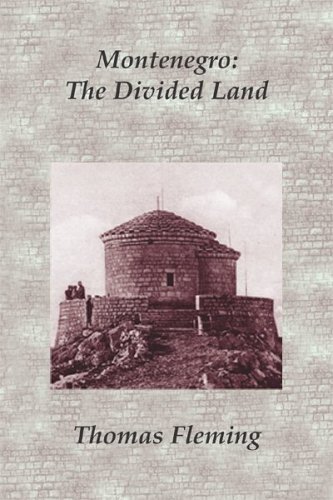Not until I was well into this book did I realize how much it is needed. The son of illiterate Serbian immigrants from Montenegro, I knew almost no early Montenegrin history. Some of that history is noble, some confused, and some characterized by treachery and double-dealing. There were plots and counterplots. Agreements were always of short duration, and reliability and trust were rare. Significantly,
there were no ancient peoples whose territory corresponded to modern Albania or Serbia, much less to Montenegro . . . it was only when Serbs from different regions were able to unite in opposition to Byzantium, under the Nemanjic dynasty, that they were able to create a successful Serbian state.
Thomas Fleming describes the rise of Zeta as a prelude to “The Serbian Golden Age”—when the Serbian state, for over 100 years, was the strongest empire in the Balkans. The period saw the building of the finest of the Serbian monasteries and the creation of Tsar Dusan’s legal code, one of two of Europe’s historic codes. Before his death in 1355, Dusan was on the verge of conquering what was left of the Byzantine Empire. But following his death came division and decline and, in 1389, the defeat by the Ottoman Turks at the Battle of Kosovo. In the centuries after Kosovo in all Serbian lands, and especially in Montenegro,
the national myth was nourished on the tales and songs of the Kosovo heroes. . . . throughout the cold dark years of misery and oppression, [the Montenegrins] warmed themselves by the fire lit in the Serbian imagination by the Kosovo story.
The chapter entitled “The Struggle for Liberation” is packed with facts, detailing Montenegro’s confrontations with Turkey, Venice, and other powers, to say nothing of domestic quarrels. What saved Montenegro from the internal disunity that afflicted Bosnia and Serbia was the institution of the vladika (bishop-prince), which gained Montenegro’s de facto independence 168 years before its formal international recognition at the Congress of Berlin. An interesting side issue was that of Scepan Mali, an impostor, who nevertheless managed what other rulers had not: He united the people and taught them respect for law and order, which helped them in the coming struggle with the invaders.
An equally important chapter, “The Road to Statehood,” highlights the critical contributions of Bishop Petar II Njegos, particularly his devotion to the Serbs, which found its highest expression in his literary masterpiece, Gorski vijenac (The Mountain Wreath). Njegos also sought to improve the economy, and he built schools and roads. His contributions should not minimize the work of his predecessors or that of his nephew, Prince Danilo Petrovic, who ruled briefly after Njegos died in October 1851.
“The Long Reign of Montenegro’s Only King” describes the rule of Prince Nikola, who proclaimed himself king in 1910, on the 50th anniversary of his reign. The most dramatic events of his tenure were the Balkan wars and World War I. Although Montenegro’s independence was widely recognized, there were many dangers that accompanied it—in particular, Austria-Hungary’s sowing of discord between the Montenegrin capital of Cetinje and Belgrade. Russia was of little help. Nikola’s rule was autocratic. (He considered it “benevolent despotism.”) In the Balkan wars, he “displayed both the courage and the pan-Serbian patriotism that were the best justification of his authoritarian regime.” In World War I, Montenegro was quickly occupied by Austria, which marked the end of the country’s independence, and the First Yugoslavia was formed in 1918. The Large Montenegrin Skupstina in November 1918 voted overwhelmingly to join Serbia in the new state.
The last two chapters (some 50 pages) deal with Montenegro in the First and the Second (and Third) Yugoslavia. In the First Yugoslavia, Montenegrins favored the common state, but many felt that Belgrade devoted too little time to Montenegrin difficulties. The Yugoslav rulers had little choice but to concentrate on the problems of Croatia, whose demands escalated.
The First Yugoslavia dovetailed with the Second Yugoslavia by virtue of the Communist victory in the civil war, often described as the conflict between the Chetniks (loyal to the Yugoslav government-in-exile) and the Communist-led Partisans. As Fleming points out, the civil war was nowhere more brutal than in Montenegro, and the Communists killed about 100,000 people in Yugoslavia after the war. The Communists made Montenegro a separate republic under Tito’s “federation,” patterned after the fictitious “federalism” of the Soviet Union. The creation of a separate republic, designed mainly to weaken Serb power and influence, meant that Montenegrins were badly divided during the whole communist period. Even after the break with the Soviet Union in 1948, Montenegrins made up 20 percent of those arrested as “Cominformists,” although Montenegrins constituted only 2.5 percent of the Yugoslav population.
As we know, the Titoist framework was a failure. Fleming maintains that Tito’s principal lieutenants did not display “the slightest talent for rebuilding a nation, managing an economy, or writing a constitution.” In the 1990’s, Fleming asserts, certain American leaders “plotted the dismemberment of a country and the destruction of a people.” Finally, he devotes some space to the future of Serbia and Montenegro in the years following the overthrow of Slobodan Milosevic.
Anyone interested in Montenegro and Serbia, as well as in the Balkans generally, should welcome Fleming’s brief but excellent book.
[Montenegro: The Divided Land, by Thomas Fleming (Rockford, IL: Chronicles Press) 172 pp., $15.00]

Leave a Reply